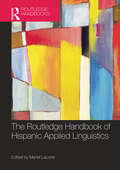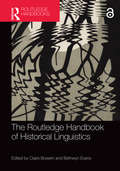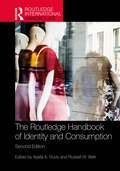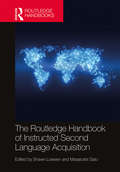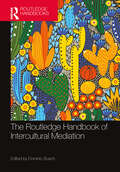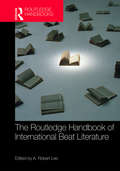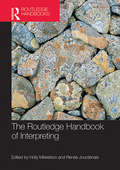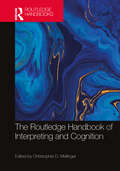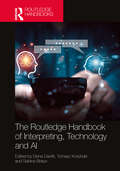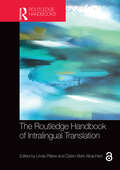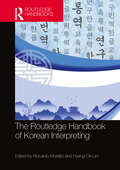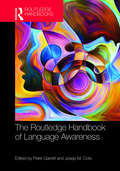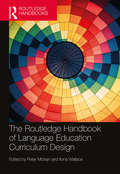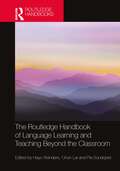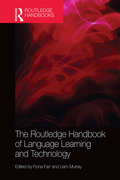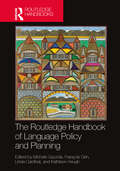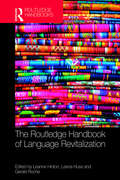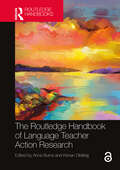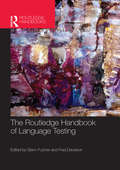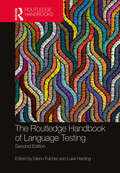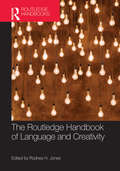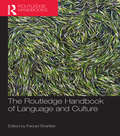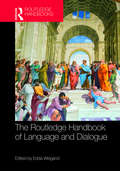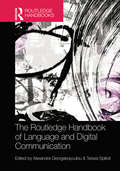- Table View
- List View
The Routledge Handbook of Hispanic Applied Linguistics (Routledge Handbooks in Applied Linguistics)
by Manel LacorteThis book provides a comprehensive overview of Hispanic applied linguistics, allowing students to understand the field from a variety of perspectives and offering insight into the ever-growing number of professional opportunies afforded to Spanish language program graduates. The goal of this book is to re-contextualize the notion of applied linguistics as simply the application of theoretical linguistic concepts to practical settings and to consider it as its own field that addresses language-based issues and problems in a real-world context. The book is organized into five parts: 1) perspectives on learning Spanish 2) issues and environments in Spanish teaching 3) Spanish in the professions 4) the discourses of Spanish and 5) social and political contexts for Spanish. The book’s all-inclusive coverage gives students the theoretical and sociocultural context for study in Hispanic applied linguistics while offering practical information on its application in the professional sector.
The Routledge Handbook of Historical Linguistics (Routledge Handbooks in Linguistics)
by Claire Bowern Bethwyn EvansThe Routledge Handbook of Historical Linguistics provides a survey of the field covering the methods which underpin current work; models of language change; and the importance of historical linguistics for other subfields of linguistics and other disciplines. Divided into five sections, the volume encompass a wide range of approaches and addresses issues in the following areas: historical perspectives methods and models language change interfaces regional summaries Each of the thirty-two chapters is written by a specialist in the field and provides: a introduction to the subject; an analysis of the relationship between the diachronic and synchronic study of the topic; an overview of the main current and critical trends; and examples from primary data. The Routledge Handbook of Historical Linguistics is essential reading for researchers and postgraduate students working in this area. Chapter 28 of this book is freely available as a downloadable Open Access PDF under a Creative Commons Attribution-Non Commercial-No Derivatives 3.0 license. https://www.routledgehandbooks.com/doi/10.4324/9781315794013.ch28
The Routledge Handbook of Identity and Consumption (Routledge International Handbooks)
by Russell W. Belk Ayalla A. Ruvio"Tell me what you eat, I'll tell you who you are," said Anthelme Brillat-Savarin. Today, "You are what you consume" is more apt. Barbara Krueger’s ironic twist of Descartes – "I shop therefore I am" – has lost its irony. Such phrases have become commonplace descriptions of our identity in the contemporary world. In our materialistic world, it seems as if there is no debate that our consumption behavior is fused with our self-identity – shaping it, changing it, and often challenging it.The Routledge Handbook of Identity and Consumption introduces the reader to state-of-the-art research, written by the world’s leading scholars regarding the interplay between identity and consumption. The book addresses the diverse issues regarding the ways identity affects our consumption behaviour and vice-versa and in doing so presents a broad perspective on the dynamics of self-identity and consumption.With chapters discussing the theory, research, and practical implications of these dynamics, including the way they change across our life span and their expression within different social, cultural, and religious contexts, this book will be a valuable reference source for students and academics from a variety of disciplines.
The Routledge Handbook of Instructed Second Language Acquisition (Routledge Handbooks in Applied Linguistics)
by Shawn Loewen Masatoshi SatoThe Routledge Handbook of Instructed Second Language Acquisition is the first collection of state-of-the-art papers pertaining to Instructed Second Language Acquisition (ISLA). Written by 45 world-renowned experts, the entries are full-length articles detailing pertinent issues with up-to-date references. Each chapter serves three purposes: (1) provide a review of current literature and discussions of cutting edge issues; (2) share the authors’ understanding of, and approaches to, the issues; and (3) provide direct links between research and practice. In short, based on the chapters in this handbook, ISLA has attained a level of theoretical and methodological maturity that provides a solid foundation for future empirical and pedagogical discovery. This handbook is the ideal resource for researchers, graduate students, upper-level undergraduate students, teachers, and teacher-educators who are interested in second language learning and teaching. .
The Routledge Handbook of Intercultural Mediation (Routledge Handbooks in Communication Studies)
by Dominic BuschOffering unique coverage of an emerging, interdisciplinary area, this comprehensive handbook examines the theoretical underpinnings and emergent conceptions of intercultural mediation in related fields of study. Authored by global experts in fields from intercultural communication and conflict resolution to translation studies, literature, political science, and foreign language teaching, chapters trace the history, development, and present state of approaches to intercultural mediation. The sections in this volume show how the concept of intercultural mediation has been constructed among different fields and shaped by its specific applications in an open cycle of influence. The book parses different philosophical conceptions as well as pragmatic approaches, providing ample grounding in the key perspectives on this growing field of discourse. The Routledge Handbook of Intercultural Mediation is a valuable reference for graduate and postgraduate students studying mediation, conflict resolution, intercultural communication, translation, and psychology, as well as for practitioners and researchers in those fields and beyond.
The Routledge Handbook of International Beat Literature (Routledge Literature Handbooks)
by A. Robert LeeBeat literature? Have not the great canonical names long grown familiar? Ginsberg, Kerouac, Burroughs. Likewise the frontline texts, still controversial in some quarters, assume their place in modern American literary history. On the Road serves as Homeric journey epic. "Howl" amounts to Beat anthem, confessional outcry against materialism and war. Naked Lunch, with its dark satiric laughter, envisions a dystopian world of power and word virus. But if these are all essentially America-centered, Beat has also had quite other literary exhalations and which invite far more than mere reception study. These are voices from across the Americas of Canada and Mexico, the Anglophone world of England, Scotland or Australia, the Europe of France or Italy and from the Mediterranean of Greece and the Maghreb, and from Scandinavia and Russia, together with the Asia of Japan and China. This anthology of essays maps relevant other kinds of Beat voice, names, texts. The scope is hemispheric, Atlantic and Pacific, West and East. It gives recognition to the Beat inscribed in languages other than English and reflective of different cultural histories. Likewise the majority of contributors come from origins or affiliations beyond the US, whether in a different English or languages spanning Spanish, Danish, Turkish, Greek, or Chinese. The aim is to recognize an enlarged Beat literary map, its creative internationalism.
The Routledge Handbook of Interpreting (Routledge Handbooks in Applied Linguistics)
by Holly Mikkelson Renée JourdenaisThe Routledge Handbook of Interpreting provides a comprehensive survey of the field of interpreting for a global readership. The handbook includes an introduction and four sections with thirty one chapters by leading international contributors. The four sections cover: The history and evolution of the field The core areas of interpreting studies from conference interpreting to interpreting in conflict zones and voiceover Current issues and debates from ethics and the role of the interpreter to the impact of globalization A look to the future Suggestions for further reading are provided with every chapter. The Routledge Handbook of Interpreting is an essential reference for researchers and advanced students of interpreting.
The Routledge Handbook of Interpreting and Cognition (Routledge Handbooks in Translation and Interpreting Studies)
by Christopher D. MellingerThe Routledge Handbook of Interpreting and Cognition provides an overview of the interrelated nature of interpreting and cognition. The Handbook presents in-depth discussions of cognitive aspects of the task of interpreting and how researchers and practitioners alike have applied these findings to the practice of interpreting. With contributions from scholars working within multiple theoretical and methodological paradigms across various disciplines, this Handbook allows readers to engage with current thinking on cognitive processes, behaviors, and activities in a single space. The volume traces the historical progression of cognitive inquiry into interpreting on various topics, highlighting methodological advances and possibilities that can further our understanding of this cross-language activity.With an editor’s introduction and 25 chapters by global authorities, the Handbook offers broad coverage of cognitive aspects of interpreting while identifying new avenues for future research. This is an essential reference for students and researchers of interpreting in translation and interpreting studies as well as those interested in cognitive aspects of interpreting in bilingualism, second-language acquisition, cognitive psychology, and beyond.
The Routledge Handbook of Interpreting, Technology and AI (Routledge Handbooks in Translation and Interpreting Studies)
by Sabine Braun Elena Davitti Tomasz KorybskiThis handbook provides a comprehensive overview of the history, development, use, and study of the evolving relationship between interpreting and technology, addressing the challenges and opportunities brought by advances in AI and digital tools.Encompassing a variety of methods, systems, and devices applied to interpreting as a field of practice as well as a study discipline, this volume presents a synthesis of current thinking on the topic and an understanding of how technology alters, shapes, and enables the interpreting task. The handbook examines how interpreting has evolved through the integration of both purpose-built and adapted technologies that support, automate, or even replace (human) interpreting tasks and offers insights into their ethical, practical, and socio-economic implications. Addressing both signed and spoken language interpreting technologies, as well as technologies for language access and media accessibility, the book draws together expertise from varied areas of study and illustrates overlapping aspects of research.Authored by a range of practicing interpreters and academics from across five continents, this is the essential guide to interpreting and technology for both advanced students and researchers of interpreting and professional interpreters.
The Routledge Handbook of Intralingual Translation (Routledge Handbooks in Translation and Interpreting Studies)
by Linda Pillière Özlem Berk AlbachtenThe Routledge Handbook of Intralingual Translation provides the first comprehensive overview of intralingual translation, or the rewording or rewriting of a text. This handbook aims to examine intralingual translation from every possible angle. The introduction gives an overview of the theoretical, political, and ideological issues involved and is followed by the first section which investigates intralingual translation from a diachronic perspective covering the modernization of classical texts. Subsequent sections consider different dialects and registers and intralingual translation from one language mode to another, explore concepts such as self-translating, trans-editing, and the role of copyeditors and investigate the increasing interest in the role of intralingual translation and second language learning. Final sections examine recent developments in intralingual translation such as the subtitling of speech for the hard-of-hearing, simultaneous Easy Language interpreting or respeaking in parliamentary debates. By providing an in-depth study on intralingual translation, the Handbook sheds light on other important areas of translation that are often bypassed including publishing practices, authorship, and ideological constraints. Authored by a range of established and new voices in the field, this is the essential guide to intralingual translation for advanced students and researchers of translation studies.
The Routledge Handbook of Intralingual Translation (Routledge Handbooks in Translation and Interpreting Studies)
by Linda Pillière Özlem Berk AlbachtenThe Routledge Handbook of Intralingual Translation provides the first comprehensive overview of intralingual translation, or the rewording or rewriting of a text.This Handbook aims to examine intralingual translation from every possible angle. The introduction gives an overview of the theoretical, political, and ideological issues involved and is followed by the first section which investigates intralingual translation from a diachronic perspective covering the modernization of classical texts. Subsequent sections consider different dialects and registers and intralingual translation from one language mode to another, explore concepts such as self-translating, transediting, and the role of copyeditors, and investigate the increasing interest in the role of intralingual translation and second language learning. Final sections examine recent developments in intralingual translation such as the subtitling of speech for the hard-of-hearing, simultaneous Easy Language interpreting, and respeaking in parliamentary debates. By providing an in-depth study on intralingual translation, the Handbook sheds light on other important areas of translation that are often bypassed, including publishing practices, authorship, and ideological constraints.Authored by a range of established and new voices in the field, this is the essential guide to intralingual translation for advanced students and researchers of translation studies.
The Routledge Handbook of Korean Interpreting (Routledge Handbooks in Translation and Interpreting Studies)
by Riccardo Moratto Hyang-Ok LimProfessor Riccardo Moratto and Professor Hyang-Ok Lim bring together the most authoritative voices on Korean interpreting. The first graduate school of interpretation and translation was established in 1979 in South Korea. Since then, not only has the interpretation and translation market grown exponentially, but so too has research in translation studies. Though the major portion of research focuses on translation, interpretation has not only managed to hold its own, but interpretation studies in Korea have been a pioneer in this field in Asia. This handbook highlights the main interpretation research trends in South Korea today, including case studies of remote interpreting during the Covid-19 pandemic, Korean interpreting for conferences, events, and diplomacy, and research into educating interpreters effectively. An essential resource for researchers in Korean interpreting, this handbook will also be very valuable to those working with other East Asian languages.
The Routledge Handbook of Language Awareness (Routledge Handbooks in Linguistics)
by Peter Garrett Josep M. CotsThe Routledge Handbook of Language Awareness is a comprehensive and informative overview of the broad field of language awareness. It contains a collection of state-of-the-art reviews of both established themes and new directions, authored and edited by experts in the field. The handbook is divided into three sections and reflects the engaging diversity of language awareness perspectives on language teaching and teachers, language learning and learners, and extending to additional areas of importance that are less directly concerned with language instruction. In their introductory chapter, the editors provide valuable background to the language awareness field along with their summary of the chapters and issues covered. A helpful section giving further reading suggestions for each of the chapters is included at the end of the book. This volume is essential reading for graduate students and researchers working in the sphere of language awareness within applied linguistics, sociolinguistics and across the wider spectrum of language and communication.
The Routledge Handbook of Language Education Curriculum Design (Routledge Handbooks in Applied Linguistics)
by Peter Mickan Ilona WallaceCurriculum design options cover a continuum from regional and school-based programs to national and international frameworks. How does policy speak to practice? What have teacher-researchers discovered through in-classroom studies? Where do you begin to describe or measure ‘effective’ language education curriculum design? The Routledge Handbook of Language Education Curriculum Design presents a comprehensive collection of essays on these issues by 31 established practitioners and new researchers. Informed by experienced scholarship and fresh studies, this handbook shares international perspectives on language education from policy and curriculum to teacher training and future directions. The handbook addresses language education curriculum design across five sections: Language curriculum design: perspectives, policies and practices Designs across the curriculum Curriculum designs in language education Curriculum resources, evaluation and assessment Teacher education, research and future projects With contributions from Australia, Brazil, Indonesia, Switzerland, Timor-Leste and more, the handbook represents the breadth of research into and the global implications for sound language education curriculum design. It considers equally the needs of students and policy makers from urban metropolises and remote communities. It is designed to reinvigorate discussions about education policy, curriculum management and the role of teacher-researchers.
The Routledge Handbook of Language Learning and Teaching Beyond the Classroom (Routledge Handbooks in Applied Linguistics)
by Hayo ReindersInformal language learning beyond the classroom plays an important and growing role in language learning and teaching. This Handbook brings together the existing body of research and unites the various disciplines that have explored this area, in order to present the current state of knowledge in one accessible resource. Much of adult learning takes place outside of formal education and for language learning, it is likely that out-of-class experiences play an equally important role. It is therefore surprising that the role of informal language learning has received little attention over the years, with the vast majority of research instead focusing on the classroom. Researchers from a range of backgrounds, however, have started to realise the important contribution of informal language learning, both in its own right, and in its relationship with classroom learning. Studies in the areas of learner autonomy, learning strategies, study abroad, language support, learners’ voices, computer-mediated communication, mobile-assisted language learning, digital gaming, and many others, all add to our understanding of the complex and intersecting ways in which learners construct their own language learning experiences, drawing from a wide range of resources, including materials, teachers, self-study, technology, other learners and native speakers. This Handbook provides a sound and comprehensive basis for researchers and graduate students to build upon in their own research of language learning and teaching beyond the classroom.
The Routledge Handbook of Language Learning and Technology (Routledge Handbooks in Applied Linguistics)
by Fiona Farr Liam MurrayThe exponential growth and development of modern technologies in all sectors has made it increasingly difficult for students, teachers and teacher educators to know which technologies to employ and how best to take advantage of them. The Routledge Handbook of Language Learning and Technology brings together experts in a number of key areas of development and change, and opens the field of language learning by exploring the pedagogical importance of technological innovation. The handbook is structured around six themes: historical and conceptual contexts core issues interactive and collaborative technologies for language learning corpora and data driven learning gaming and language learning purpose designed language learning resources. Led by fundamental concepts, theories and frameworks from language learning and teaching research rather than by specific technologies, this handbook is the essential reference for all students, teachers and researchers of Language Learning and TESOL. Those working in the areas of Applied Linguistics, Education and Media Studies will also find this a valuable book.
The Routledge Handbook of Language Policy and Planning (Routledge Handbooks in Applied Linguistics)
by Linda Cardinal Michele Gazzola Kathleen Heugh François GrinThe Routledge Handbook of Language Policy and Planning is a comprehensive and authoritative survey, including original contributions from leading senior scholars and rising stars to provide a basis for future research in language policy and planning in international, national, regional, and local contexts. The Handbook approaches language policy as public policy that can be studied through the policy cycle framework. It offers a systematic and research-informed view of actual processes and methods of design, implementation, and evaluation. With a substantial introduction, 38 chapters and an extensive bibliography, this Handbook is an indispensable resource for all decision makers, students, and researchers of language policy and planning within linguistics and cognate disciplines such as public policy, economics, political science, sociology, and education.
The Routledge Handbook of Language Revitalization (Routledge Handbooks in Applied Linguistics)
by Leanne Hinton Leena Huss Gerald RocheThe Routledge Handbook of Language Revitalization is the first comprehensive overview of the language revitalization movement, from the Arctic to the Amazon and across continents. Featuring 47 contributions from a global range of top scholars in the field, the handbook is divided into two parts, the first of which expands on language revitalization issues of theory and practice while the second covers regional perspectives in an effort to globalize and decolonize the field. The collection examines critical issues in language revitalization, including: language rights, language and well-being, and language policy; language in educational institutions and in the home; new methodologies and venues for language learning; and the roles of documentation, literacies, and the internet. The volume also contains chapters on the kinds of language that are less often researched such as the revitalization of music, of whistled languages and sign languages, and how languages change when they are being revitalized. The Routledge Handbook of Language Revitalization is the ideal resource for graduate students and researchers working in linguistic anthropology and language revitalization and endangerment.
The Routledge Handbook of Language Teacher Action Research (Routledge Handbooks in Applied Linguistics)
by Anne Burns Kenan DikilitaşThe Routledge Handbook of Language Teacher Action Research is an authoritative and innovative treatment of language teacher action research (LTAR) as a growing research field.Edited by two global thought leaders in LTAR, it features 34 original thematic contributions from a global range of experts at the cutting edge of the field, providing a comprehensive survey not found in any other single publication. Initiatives across the world are demonstrating the value of LTAR, which has been shown to provide language teachers with strong, exciting, and influential opportunities for learning, and gaining a feeling of empowerment. This groundbreaking Handbook theorises these premises from multiple perspectives in specific areas of language teacher education and curates a broad range of original content that integrates the practical and theoretical knowledge that has emerged over the years since LTAR began to develop.This volume is a groundbreaking guide for researchers of language teaching, as well as practitioners and educators that want to harness the potential of LTAR in both theory and practice.
The Routledge Handbook of Language Testing (Routledge Handbooks in Applied Linguistics)
by Fred Davidson Glenn FulcherWinner of the SAGE/ILTA Book Award 2016 The Routledge Handbook of Language Testing will provide a comprehensive account of the area of language assessment and testing. Written by leading specialists from around the world, this volume brings together approximately 35 authoritative articles (around 8000 words each). The proposed outline for the Handbook (below) is divided into ten sections. The section titles reflect the contents of their Language Testing and Assessment –textbook in our RAL series and sketch a useful overview of the discipline. Each chapter has been carefully selected to relate to key issues raised in the respective topic, providing additional historical background, critical discussion, reviews of key research methods, and an assessment of what the future might hold.
The Routledge Handbook of Language Testing (Routledge Handbooks in Applied Linguistics)
by Luke Harding Glenn FulcherThis second edition of The Routledge Handbook of Language Testing provides an updated and comprehensive account of the area of language testing and assessment. The volume brings together 35 authoritative articles, divided into ten sections, written by 51 leading specialists from around the world. There are five entirely new chapters covering the four skills: reading, writing, listening, and speaking, as well as a new entry on corpus linguistics and language testing. The remaining 30 chapters have been revised, often extensively, or entirely rewritten with new authorship teams at the helm, reflecting new generations of expertise in the field. With a dedicated section on technology in language testing, reflecting current trends in the field, the Handbook also includes an extended epilogue written by Harding and Fulcher, contemplating what has changed between the first and second editions and charting a trajectory for the field of language testing and assessment. Providing a basis for discussion, project work, and the design of both language tests themselves and related validation research, this Handbook represents an invaluable resource for students, researchers, and practitioners working in language testing and assessment and the wider field of language education.
The Routledge Handbook of Language and Creativity (Routledge Handbooks in English Language Studies)
by Rodney H. JonesThe Routledge Handbook of Language and Creativity provides an introduction to and survey of a wide range of perspectives on the relationship between language and creativity. Defining this complex and multifaceted field, this book introduces a conceptual framework through which the various definitions of language and creativity can be explored. Divided into four parts, it covers: different aspects of language and creativity, including dialogue, metaphor and humour literary creativity, including narrative and poetry multimodal and multimedia creativity, in areas such as music, graffiti and the internet creativity in language teaching and learning. With over 30 chapters written by a group of leading academics from around the world, The Routledge Handbook of Language and Creativity will serve as an important reference for students and scholars in the fields of English language studies, applied linguistics, education, and communication studies.
The Routledge Handbook of Language and Culture (Routledge Handbooks in Linguistics)
by Farzad SharifianThe Routledge Handbook of Language and Culture presents the first comprehensive survey of research on the relationship between language and culture. It provides readers with a clear and accessible introduction to both interdisciplinary and multidisciplinary studies of language and culture, and addresses key issues of language and culturally based linguistic research from a variety of perspectives and theoretical frameworks. This Handbook features thirty-three newly commissioned chapters which cover key areas such as cognitive psychology, cognitive linguistics, cognitive anthropology, linguistic anthropology, cultural anthropology, and sociolinguistics offer insights into the historical development, contemporary theory, research, and practice of each topic, and explore the potential future directions of the field show readers how language and culture research can be of practical benefit to applied areas of research and practice, such as intercultural communication and second language teaching and learning. Written by a group of prominent scholars from around the globe, The Routledge Handbook of Language and Culture provides a vital resource for scholars and students working in this area.
The Routledge Handbook of Language and Dialogue
by Edda WeigandThe Routledge Handbook of Language and Dialogue is the first comprehensive overview of the emerging and rapidly growing sub-discipline in linguistics, Language and Dialogue. Edited by one of the top scholars in the field, Edda Weigand, and comprising contributions written by a variety of likewise influential figures, the handbook aims to describe the history of modern linguistics as reasoned progress leading from de Saussure and the simplicity of artificial terms to the complexity of human action and behaviour, which is based on the integration of human abilities such as speaking, thinking, perceiving, and having emotions. The book is divided into three sections: the first focuses on the history of modern linguistics and related disciplines; the second part focuses on the core issues and open debates in the field of Language and Dialogue and introduces the arguments pro and contra certain positions; and the third section focuses on the three components that fundamentally affect language use: human nature, institutions, and culture. This handbook is the ideal resource for those interested in the relationship between Language and Dialogue, and will be of use to students and researchers in Linguistics and related fields such as Discourse Analysis, Cognitive Linguistics, and Communication.
The Routledge Handbook of Language and Digital Communication (Routledge Handbooks in Applied Linguistics)
by Alexandra Georgakopoulou Tereza SpiliotiThe Routledge Handbook of Language and Digital Communication provides a comprehensive, state of the art overview of language-focused research on digital communication, taking stock and registering the latest trends that set the agenda for future developments in this thriving and fast moving field. The contributors are all leading figures or established authorities in their areas, covering a wide range of topics and concerns in the following seven sections: • Methods and Perspectives; • Language Resources, Genres, and Discourses; • Digital Literacies; • Digital Communication in Public; • Digital Selves and Online-Offline Lives; • Communities, Networks, Relationships; • New debates and Further directions. This volume showcases critical syntheses of the established literature on key topics and issues and, at the same time, reflects upon and engages with cutting edge research and new directions for study (as emerging within social media). A wide range of languages are represented, from Japanese, Greek, German and Scandinavian languages, to computer-mediated Arabic, Chinese and African languages. The Routledge Handbook of Language and Digital Communication will be an essential resource for advanced undergraduates, postgraduates and researchers within English language and linguistics, applied linguistics and media and communication studies.
